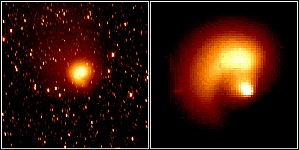

The nucleus of Hale-Bopp is estimated to be about 30 to 40 km across - Comet Halley's nucleus was estimated at 8 x 8 x 16 km. The nucleus is exhibiting sudden brief eruptions and a complex mottled surface. Its absolute magnitude of -1 makes it one of the brightest comets to reach the inner solar system in history. Closest approach to Earth will occurred on 22 March 1997 at a distance of 1.3 A.U. It made for a spectacular view in the March morning sky, and will be in the evening skies from mid-March to early May. Closest approach to the Sun was on 31 March at a distance of .91 A.U. The comet is estimated to have last passed by the Sun about 4200 years ago.
Hale-Bopp was visible low in the northern hemisphere pre-dawn sky in February to the ENE just below the constellation Cygnus. By the end of March the comet moved from Cygnus to Lacerta to Andromeda in the NE pre-dawn sky. The comet will be disappearing from the pre-dawn sky at the beginning of April. Since mid-March, however, the comet has also been visible in the early evening sky to the NW to WNW, at the bottom of Perseus. The comet will become higher in the sky through mid-April, and then move down towards the horizon by early May. The comet is currently one of the brightest objects in the sky and the tail is spectacular.
Heliocentric coordinates of Hale-Bopp - for any given dates
Results of IUE and Hubble observations of Hale-Bopp - 27 March 1997
NASA plans to observe Hale-Bopp - 13 March 1997
NASA Hale-Bopp Press Release - 11 October 1995
Observing Information - SEDS
Russell Sipes' Hale-Bopp Field Guide
Hale-Bopp and the total solar eclipse of 1997
Hale-Bopp sounding rocket missions from White Sands - Launched on March 24, 25, 29; April 5
Scienceweb - Canada
National Astronomical Observatory - Japan
Instituto de Astrofisica de Canarias - Canary Islands, Spain
From the Nine Planets (SEDS, Univ. of Arizona)
From Views of the Solar System (C.J. Hamilton, Los Alamos)
NSSDCA Planetary Science Home Page
 Author/Curator:
Author/Curator: